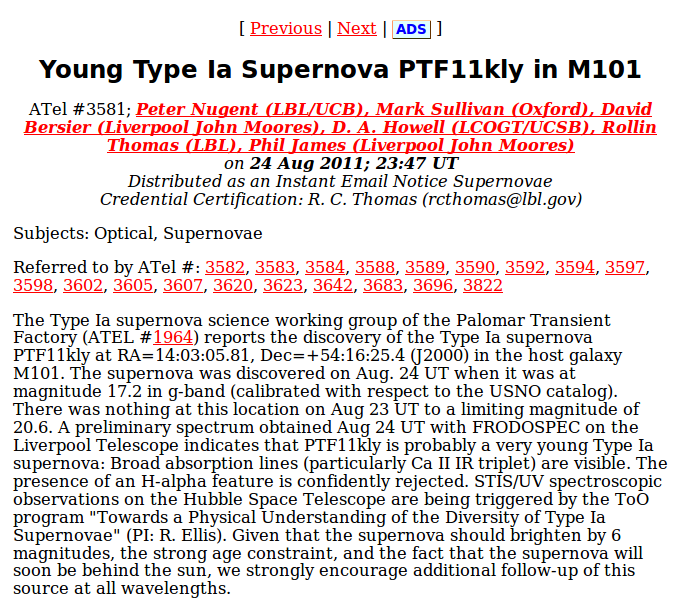
 Copyright © Michael Richmond.
This work is licensed under a Creative Commons License.
Copyright © Michael Richmond.
This work is licensed under a Creative Commons License.
Believe it or not, it's possible to make some contributions to the field of extragalactic astronomy even from the light-polluted campus of RIT. The opportunities arise only rarely, but with a little luck, and good weather, one can take advantage of them to help other astronomers with much bigger telescopes and much better sites.
In August, 2011, just a little less than one year ago, a supernova was discovered in the nearby galaxy M101.
Not only was this much closer than the typical supernova, but it was also discovered very early in its evolution -- about one day after the explosion began. This gave astronomers a rare chance to measure properties of a Type Ia supernova with very high precision.
Let me tell you about our study of this supernova at RIT. I'll provide some background for those who aren't members of the supernova community.
A supernova explosion involves the titanic destruction of an entire star, producing an extremely luminous lightshow for several weeks or months. There are several different types of supernovae, distinguished by features of their spectra.
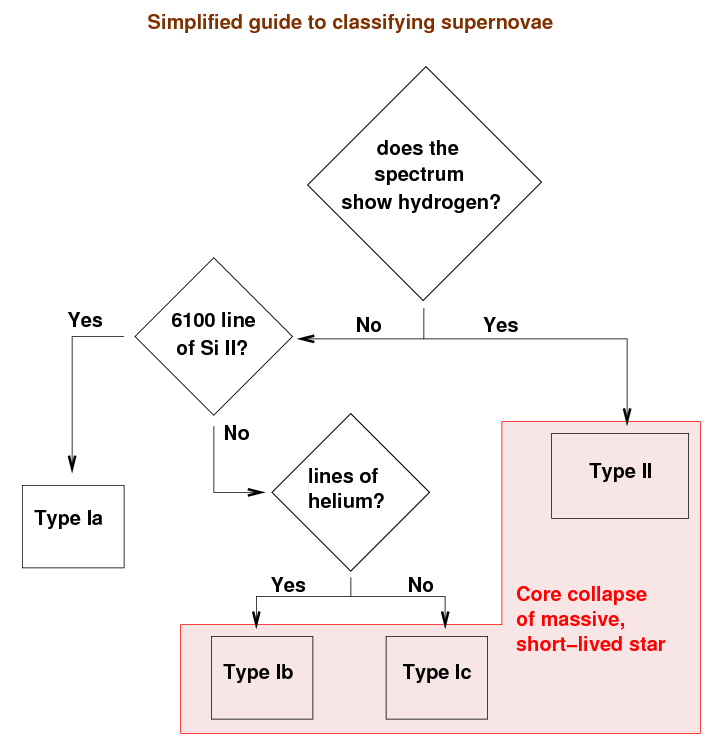
Massive stars which run out of fuel in their cores and undergo a catastrophic core collapse can exhibit different types of spectra and very different light curves. Type Ia supernovae, on the other hand, are somewhat homogeneous: they all tend to have similar spectra, similar light curves, and similar overall luminosity. That makes them very useful for the study of cosmology, since we can use them as standard candles*
* Danger, danger Will Robinson! See caveats below.
What exactly causes a Type Ia supernova? The answer isn't known -- or, more accurately, there's no agreement on the answer. One possibility is a single white dwarf accreting material from a nearby companion until its mass exceeds the Chandrasekhar limit. Another model involves the merger of two white dwarfs which are in a very tight binary system, again to create a single object with a super-Chandrasekhar mass. There is evidence for both models and the discussion continues.
The important thing is that if one can use Type Ia supernova as standard candles, then they allow us to measure two very important numbers:
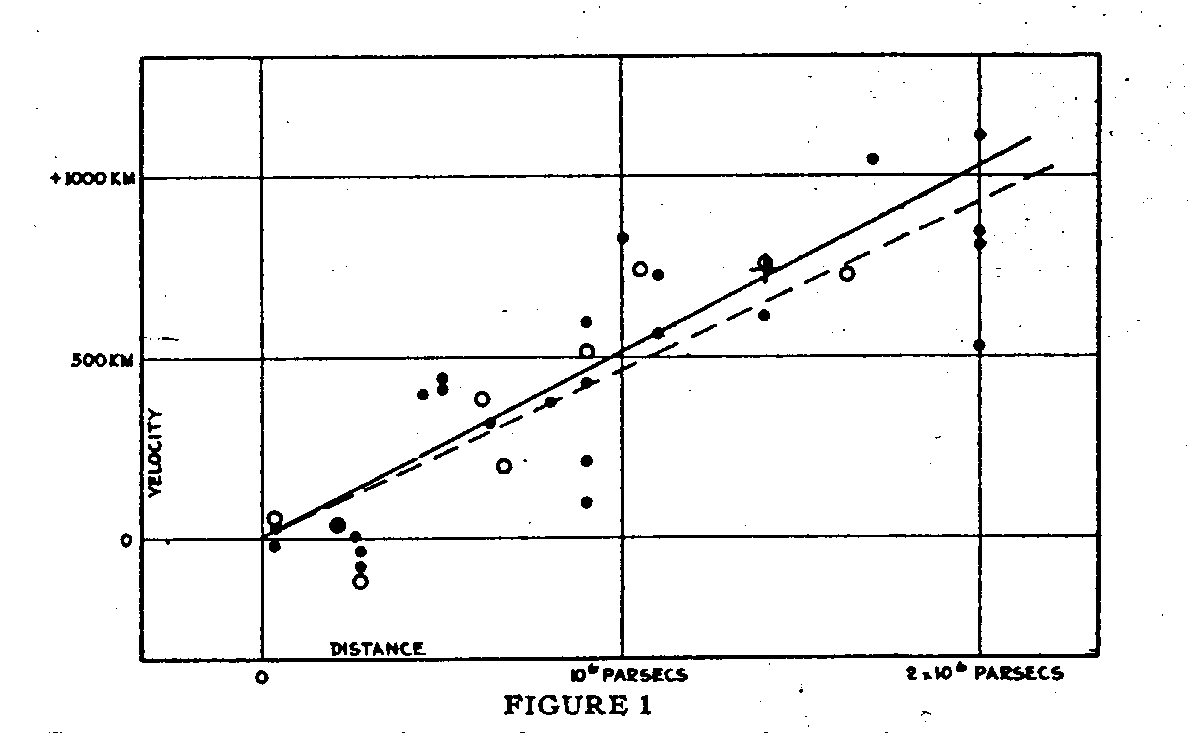
Figure taken from
Hubble, "Proceedings of the National Academy
of Sciences Volume 15 : March 15, 1929 : Number 3"
Because Type Ia SNe are so luminous, we can measure their
properties at very large distances.
If they do indeed have the same intrinsic luminosity,
the decrease in their apparent brightness as a function
of redshift reveals the large-scale geometry of the
universe.
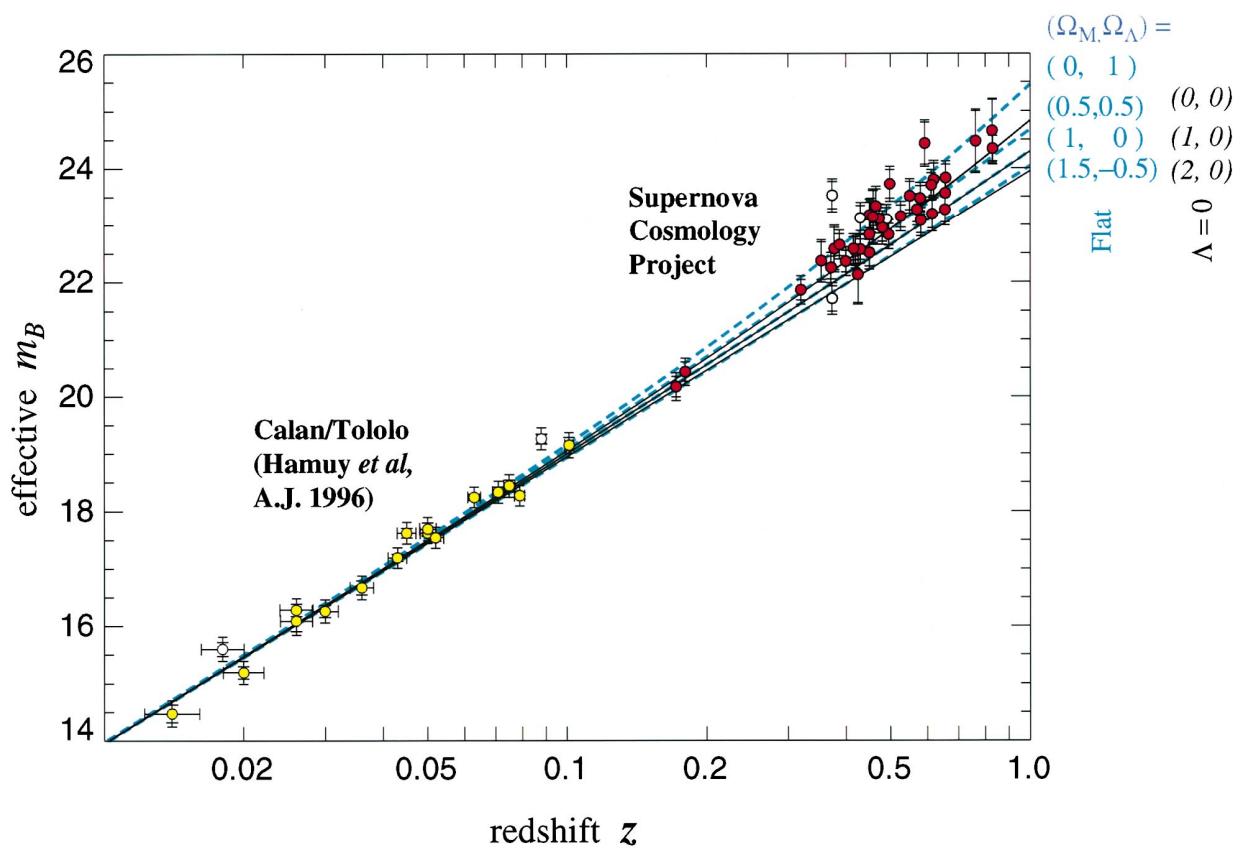
Figure taken from
Perlmutter et al., ApJ 517, 565 (1999)
This sounds great -- all type Ia supernovae are exactly the same brightness! We can use them easily for all sorts of cosmological tests.
Right? Right?
Well, no, not really.
It turns out that while almost all type Ia supernovae do fall within a relatively narrow range of limits, and while a decent fraction of them really DO seem to be nearly identical, their properties do span quite a range. For example, look at these absolute magnitudes:
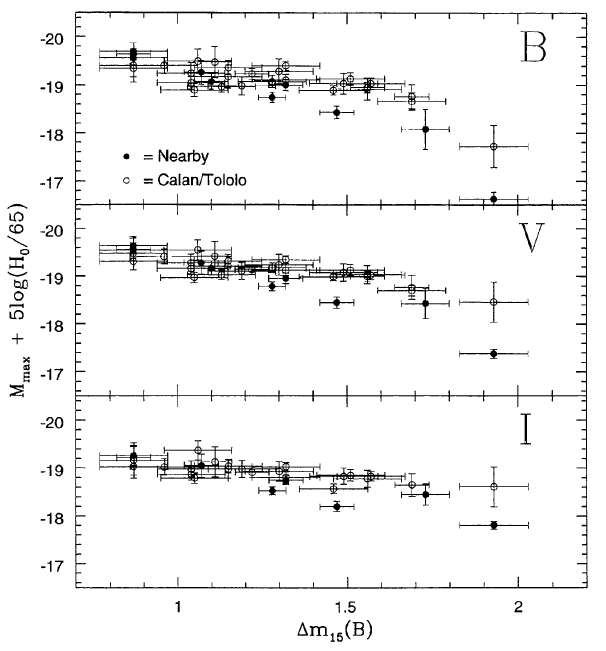
Figure taken from
Hamuy et al., AJ 112, 2391 (1996)
Some supernovae are more than 1 magnitude (2.5 times) more luminous than others. Does that sound like a good standard candle? No, of course not.
On the other hand, there does appear to be a relationship between the absolute magnitude of a type Ia supernova and other properties. On the horizontal axis of the graphs above is the parameter called "delta m15", which is just the amount by which the supernova fades in the first 15 days after its maximum light. It seems that
There are other properties which correlate with luminosity, and astronomers have devised several methods which attempt to convert the observed luminosity to a "standard" luminosity. After making such corrections, it seems that the truly random scatter among the peak luminosity of (at least some) type Ia supernovae is only about +/- 15 percent.
Astronomers who wish to use supernovae for cosmological purposes need to answer two questions:
This is where the RIT Observatory and I come into the picture, in our very minor way. The galaxy M101 is one of the closest big spiral galaxies to our Milky Way, being only about 6.7 Mpc (29.1 mag) away from us.
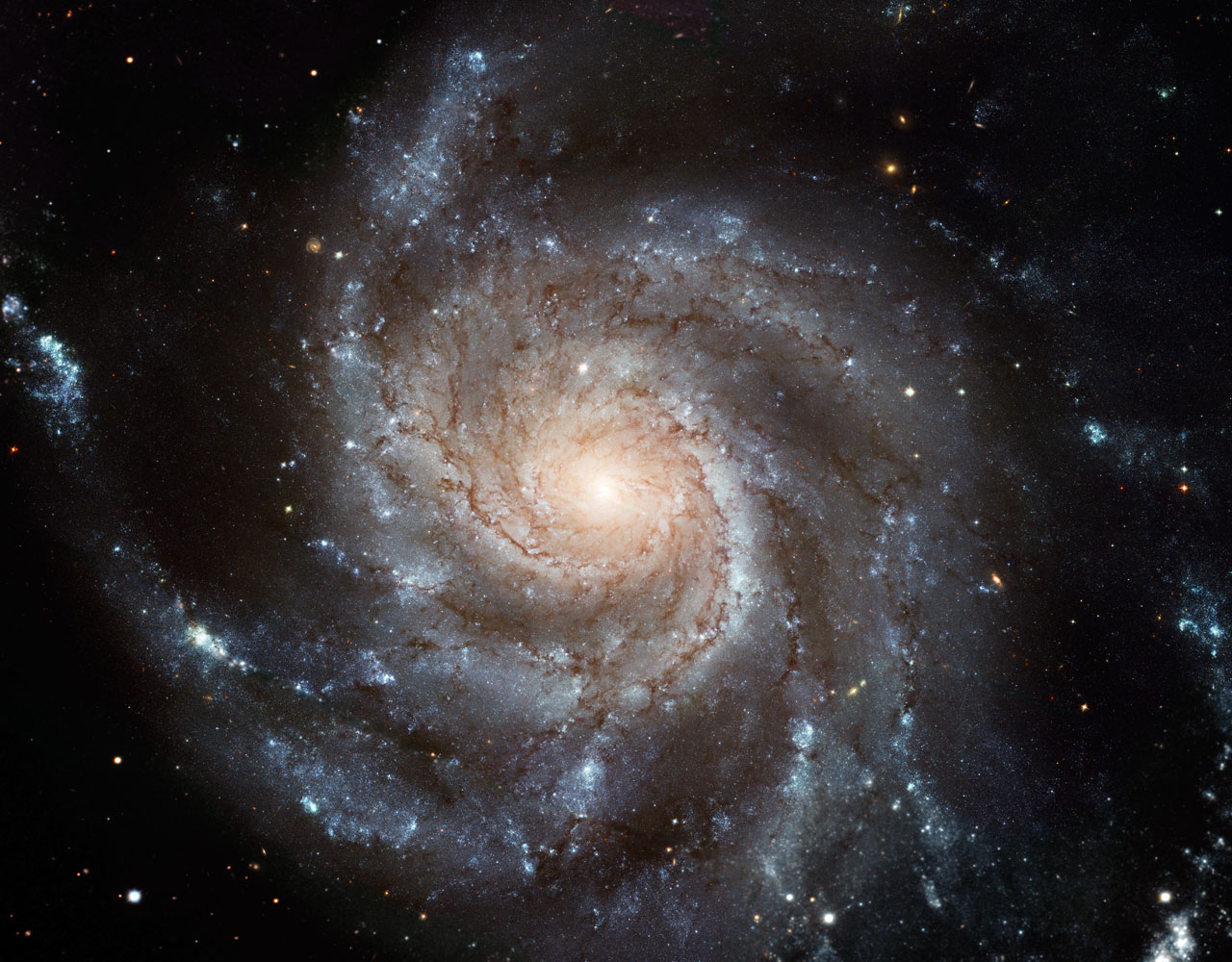
That means that any supernova in M101 will appear much brighter than the average supernova in our skies. And, indeed, SN 2011fe was the third-brightest supernova visible from Earth in the past 25 years (and perhaps in the past 100 years).
supernova peak apparent magnitude visible with ---------------------------------------------------------- 1987A 2.97 naked eye 1972E 8.68(*) binoculars 2011fe 9.99 small telescope 1993J 10.85 small telescope ---------------------------------------------------------- (*) brightest measured value -- discovered after maximum light
The supernova discovery was announced on Aug 24, 2011, at about 7:50 PM Eastern Daylight Time (that's Aug 25, 2011, in Universal Time), by the Palomar Transient Factory.
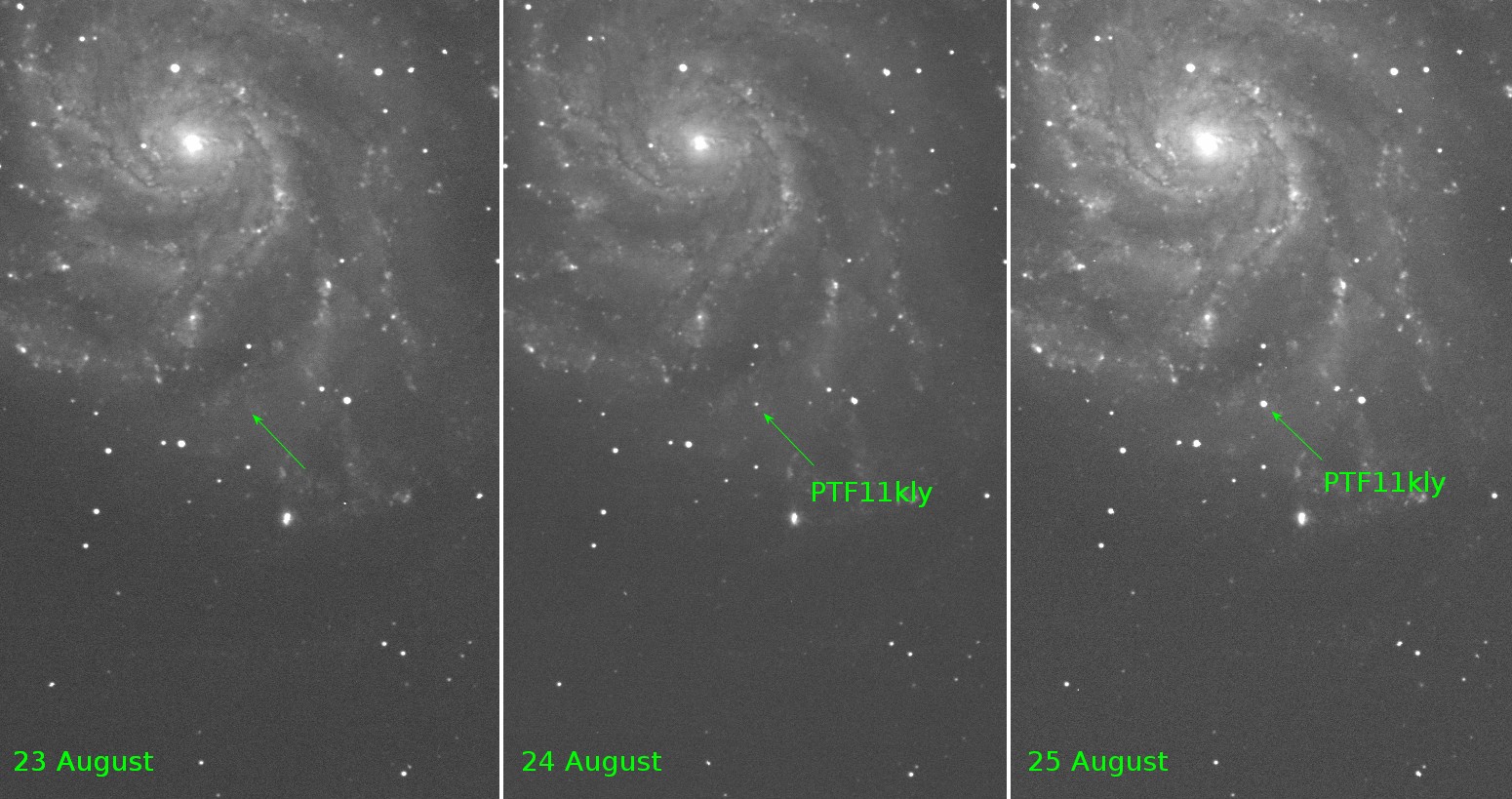
The next night, Aug 25, I started observing the supernova from the RIT Observatory with our 12-inch telescope and SBIG ST-8E CCD camera. Our images weren't very pretty, but they did show the supernova and several nearby stars of similar brightness which served as references. You can see a list of our observing sessions by going to the RIT Observatory record and scrolling down to the end.
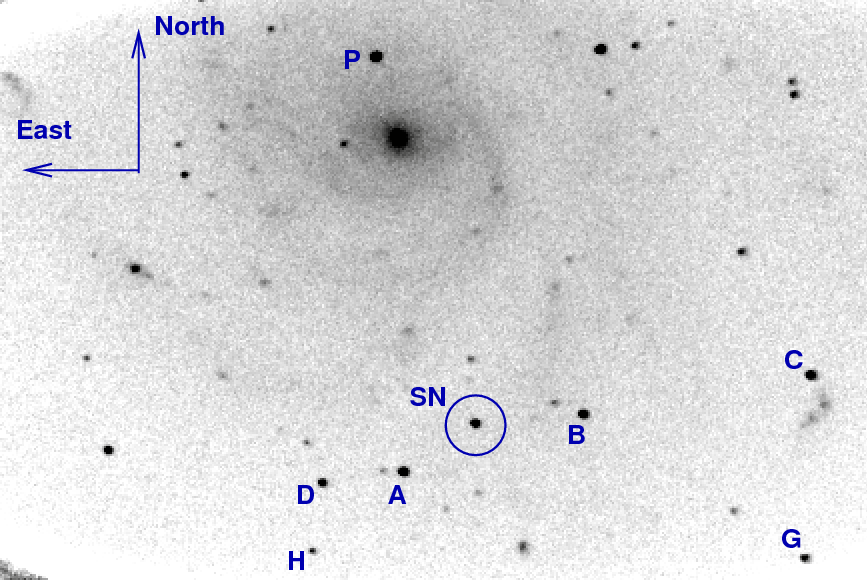
I measured the brightness of the SN in four optical passbands, using Johnson-Cousins BVRI filters.
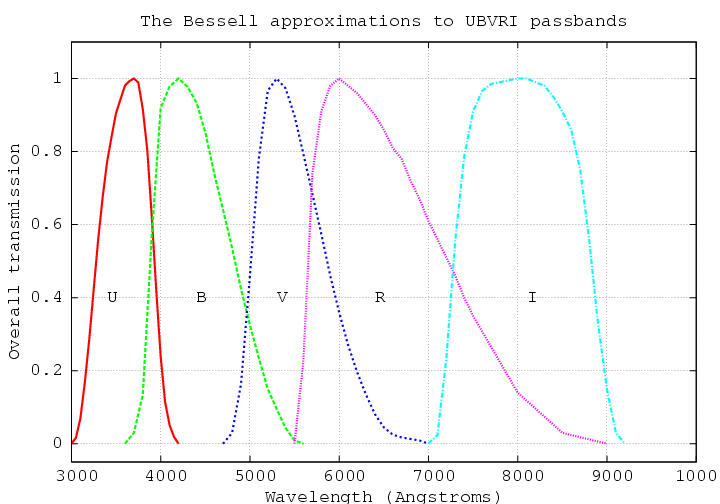
At first, the supernova was very blue, compared to the ordinary reference stars. An image in the B filter is at left, in the I filter at right. Note that the camera is a LOT more sensitive to light in the I-band!
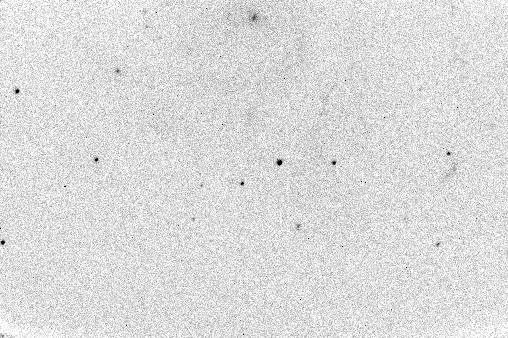
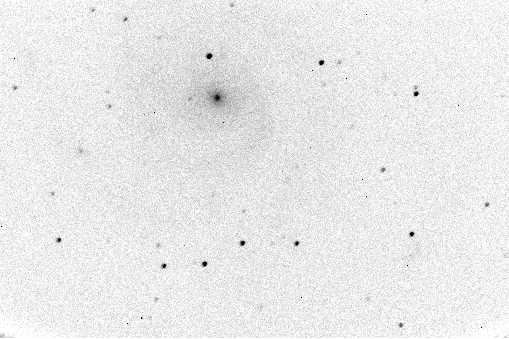
I tried to make measurements on every clear night. The bad news (scientifically) is that the skies in Rochester aren't clear all that often. The good news (from a mental health standpoint) is that the skies in Rochester aren't clear all that often. Over the next 180 days, I was able to acquire data on 50 nights. The figure below shows all our data, plus that collected by astronomers at Michigan State University.
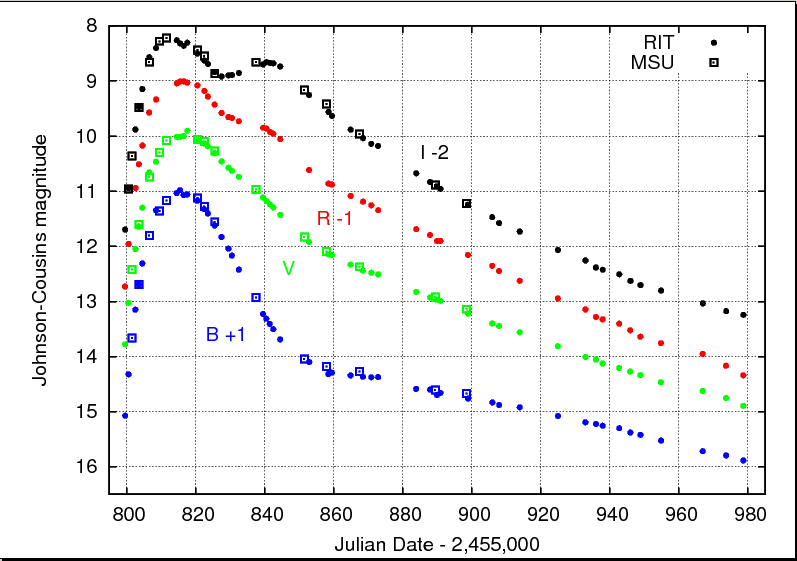
As August turned to September, and September turned to October, M101 gradually set earlier and earlier. By mid-October, the galaxy was so low at sunset that I could barely see it. Fortunately, M101 is nearly circumpolar from our latitude, so all I had to do was wait six or seven hours for it to rise again in the east.
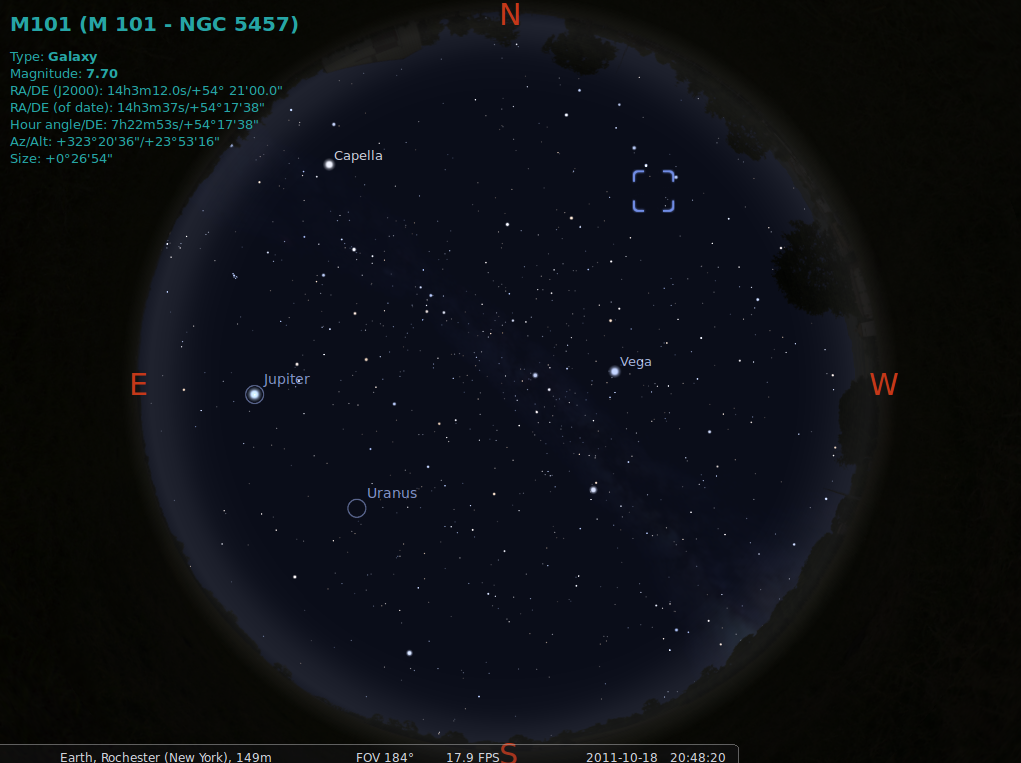
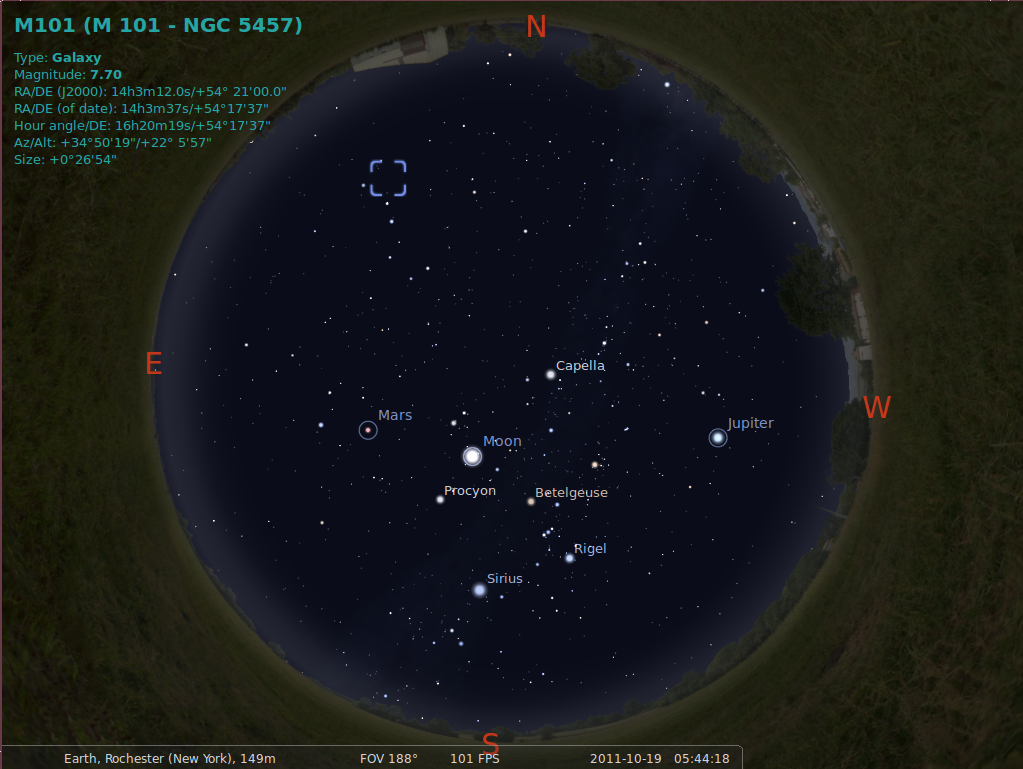
In February, 2012, the supernova had faded so much that it was hard to measure it accurately, especially in the I-band. Even after co-adding a number of images, the signal was just too small. So, I stopped the observations after Feb 20, 2012.
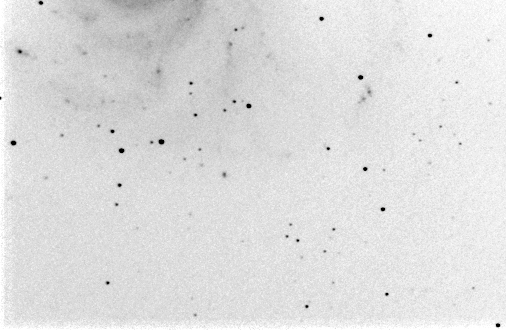
One of the worries in this business is that, as a supernova fades, its light becomes contaminated more and more strongly by other stars or nebulosity in its host galaxy. That can lead to a systematic error in the photometry which grows with time. I checked the HST archive for images of M101 and found several pictures taken long before the SN exploded. The closeup below is an image in the I-band equivalent filter F814W. The circles are centered on the position of the supernova with radii 0.5 and 2.5 arcseconds. The two nearest bright objects are the multiple star "P" and the single star "Q", which have apparent magnitudes of I=21.8 and I=22.2, respectively. Since SN 2011fe had an apparent magnitude of I=15.2 when I stopped observing it, it was at least 100 times brighter than these nearby objects, and so my measurements were not affected significantly.
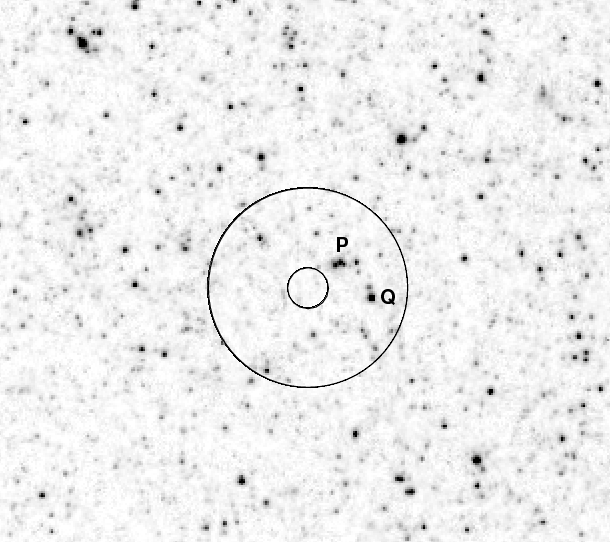
The story of SN 2011fe is still being told. Astronomers continue to measure its radiation at many wavelengths, and many of the observations have yet to be published. Let me mention just a few things which seem clear at this point.
Vinko et al. (2012) determined the interval from explosion to maximum light was about 17.2 days, very similar to the value of 17.4 days for other "normal" type Ia events.
Moreover, there was relatively little interstellar extinction, in either the Milky Way or M101. We don't have to make big corrections to the observations in order to determine the intrinsic properties of the supernova.
M101 is close enough that astronomers can determine its distance via several methods. The best estimates yield a distance modulus of about (m-M) = 29.10 mag, which combined with the observed apparent magnitude of m(V) = 9.99 and extinction of A(V) = 0.08 mag, results in an absolute magnitude of M(V) = -19.18.
Measurements of other supernovae suggest that a type Ia which declines at the rate of SN 2011fe ought to have an absolute magnitude of M(V) = -19.19. Wow --- right on the money.
Some type Ia supernova have light curves which decline quickly, and others decline slowly. Astronomers have devised a number of methods for measuring this property and then using it to correct the peak brightness to a "standard" value. Two of the most widely used methods are called "SALT2" ( Guy et al. 2007 ) and "MLCS2k2" ( Jha, Riess and Kirshner 2007 ). In an ideal world, astronomers would get the same answers after applying either of these corrections. Alas, as Vinko et al. (2012) demonstrate, we DON'T get the same result. The process is rather involved, but the bottom line is that they find
These two values don't quite overlap at the one-sigma level. The gap between them, moreover, is 0.16 magnitudes. Recall that the intrinsic scatter among type Ia supernova, after correction, is about 0.15 magnitudes. If different groups of astronomers use different algorithms to analyze type Ia SN light curves, their results may have a significant offset ...
Well, we already knew this. The spectral response of the human eye is not exactly the same as that of the astronomical "V" passband, although they are (not by coincidence) pretty close. SN 2011fe was bright enough that it was measured by many visual observers, using their eyes to compare the supernova to other stars in the field of their eyepiece. A comparison of the visual and V-band measurements shows the same relationship seen in other studies: the human eye is a bit more sensitive (relative to the V-band) to blue objects.
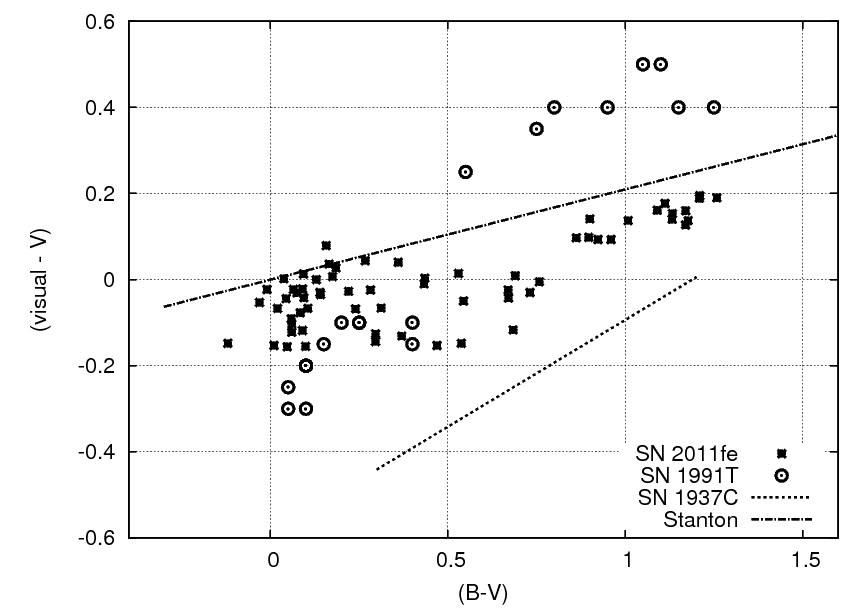
 Copyright © Michael Richmond.
This work is licensed under a Creative Commons License.
Copyright © Michael Richmond.
This work is licensed under a Creative Commons License.